Termite damage can be a homeowner’s worst nightmare. These tiny pests can silently destroy the structural integrity of your home before you even know they’re there. So the big question is: Will insurance cover termite damage? The short answer? Usually not. But like most things with insurance, the full answer is a bit more complex—and important to understand.
In this article, we’ll break down what’s typically covered, what’s not, and how you can protect your home from costly termite infestations.
Understanding the Basics: What Does Homeowners Insurance Usually Cover?
Homeowners insurance is designed to protect you from sudden and accidental damage. It generally covers things like:
- Fire and smoke damage
- Weather-related damage (hail, windstorms, lightning)
- Theft and vandalism
- Certain types of water damage (burst pipes, for example)
Unfortunately, most pest-related damage falls outside of that scope. That includes infestations from termites, rodents, and other critters.
Why Termite Damage Isn’t Typically Covered
Insurance companies consider termite damage to be preventable with regular home maintenance. Since termites work slowly over time, their destruction isn’t considered “sudden” or “accidental.” So if you’re wondering, will insurance cover termite damage?—the answer is typically no. Instead, it’s categorized as a maintenance issue, which falls on the homeowner to manage.
Think of it like this: if your roof leaks because you never cleaned your gutters, that’s on you—not your insurer. Same goes for termites.
Exceptions to the Rule: When Might Insurance Cover Termite Damage?
Although termite damage usually isn’t covered by standard homeowners insurance, there are some rare scenarios where it might be.
1. When Termites Cause a Covered Peril
Let’s say termites chew through your home’s wiring, causing a fire. Fire is a covered peril—so in that case, the resulting fire damage could be covered, even if the termite issue wasn’t.
- Example: A termite-chewed wire starts a house fire. Your policy likely covers the fire and smoke damage, but not the termite damage that led to it.
- Another example: A floor collapses suddenly due to termite damage, and someone gets hurt. You may be able to make a case for coverage depending on the circumstances and policy language.
2. Hidden or Unknown Damage
Some insurers offer add-ons or endorsements for hidden insect damage—especially in areas where termites are more common. This coverage isn’t standard and usually comes at an additional cost.
- Check your policy for terms like “hidden damage” or “wood-destroying insects.”
- If you’re unsure, talk to your insurance agent. They can clarify what’s included and what’s not.
Signs of Termite Damage You Should Never Ignore
One reason termite damage often goes uncovered is that homeowners don’t recognize the signs early enough. Here are some red flags to look for:
- Hollow-sounding wood
- Mud tubes on walls or foundations
- Discarded wings near windowsills or doors
- Frass (termite droppings) that look like sawdust
- Bubbling or uneven paint
Catching these signs early can save you thousands in repairs—and potentially help in filing a claim if the damage leads to a covered peril.
Steps to Take If You Discover Termite Damage
If you think termites are attacking your home, don’t panic—but act fast. Here’s what to do:
1. Call a Licensed Pest Control Professional
- Don’t try to handle a termite infestation on your own.
- Professionals can assess the extent of the damage and recommend treatment.
2. Document Everything
- Take photos of the damage, pest activity, and any related issues.
- Save inspection reports and treatment receipts.
3. Contact Your Insurance Company
Even if you suspect it’s not covered, it’s worth calling your insurer. There may be some exceptions or endorsements that could apply to your situation.
- Be clear, honest, and thorough in your explanation.
- Ask specifically if your policy includes coverage for insect-related damage or any add-ons that might help.
How to Prevent Termite Damage Before It Starts
Since the answer to ‘will insurance cover termite damage’ is usually no, your best line of defense is prevention. Here’s how to keep termites away and protect your investment:
✅ Schedule Annual Termite Inspections
- Most pest control companies offer affordable annual inspections.
- Early detection is key to avoiding major damage.
✅ Keep Wood Away from Your Home’s Foundation
- Firewood, mulch, and even cardboard boxes can attract termites.
- Store materials at least 20 feet from your house.
✅ Fix Moisture Problems Quickly
- Termites love moisture. Leaky pipes, clogged gutters, and damp basements are all red flags.
- Repair any water issues promptly.
✅ Seal Cracks and Gaps
- Close up any openings in your foundation or siding.
- This helps prevent termites and other pests from getting in.
What About Termite Bonds and Pest Warranties?
If you’re in a termite-prone area, consider investing in a termite bond or warranty from a licensed pest control company. These can provide peace of mind in case an infestation occurs.
What’s Included?
- Annual inspections
- Preventative treatments
- Coverage for retreatments or repairs, depending on the agreement
While these aren’t substitutes for homeowners insurance, they can help fill in the gaps when it comes to termite-related expenses.
Final Thoughts: So, Will Insurance Cover Termite Damage?
To recap:
- Standard homeowners insurance usually does NOT cover termite damage.
- Coverage may apply indirectly if termites cause a covered peril, like a fire or collapse.
- Preventative measures and annual inspections are your best defense.
- Consider termite bonds or pest warranties for added protection.
If you’re concerned about potential termite issues, review your current homeowners insurance policy and talk to your agent. You might find that there are add-ons available to give you more comprehensive protection.
Termite damage can be costly, but being proactive—and informed—can help you avoid financial disaster.
